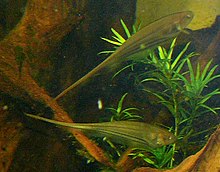Our website is made possible by displaying online advertisements to our visitors.
Please consider supporting us by disabling your ad blocker.
Glass knifefish
| Glass knifefishes Temporal range:
| |
|---|---|

| |
| Eigenmannia virescens | |
| Scientific classification | |
| Domain: | Eukaryota |
| Kingdom: | Animalia |
| Phylum: | Chordata |
| Class: | Actinopterygii |
| Order: | Gymnotiformes |
| Suborder: | Sternopygoidei |
| Superfamily: | Apteronotoidea |
| Family: | Sternopygidae Cope, 1871 |
Glass knifefishes are fishes in the family Sternopygidae in the order Gymnotiformes. Species are also known as rattail knifefishes.[1]
These fishes inhabit freshwater streams and rivers in Panama and South America.[1] Many species are specialized for life in the deep (more than 20 m or 66 ft) swiftly moving waters of large river channels, like that of the Amazon and its major tributaries[2] where they have been observed swimming vertically.[3] Sternopygus species inhabit both streams and rivers.[4]
Many species are highly compressed laterally and translucent in life.[4] These fish have villiform (brush-like) teeth on the upper and lower jaws. The snout is relatively short. The eyes are relatively large, with a diameter equal to or greater than the distance between nares. The anal fin originates at the isthmus (the strip of flesh on the ventral surface between the gill covers). The maximum length is 140 cm (55 in) in Sternopygus macrurus.
Eigenmannia vicentespelaea is the only cave-dwelling gymnotiform. Humboldtichthys kirschbaumi (formerly genus Ellisella) from Upper Miocene of Bolivia is the only fossil gymnotiform.[1]
These fish have a tone-like electric organ discharge (EOD) that occurs monophasically.
Some of these species are aquarium fishes.
- ^ a b c Nelson, Joseph, S. (2006). Fishes of the World. John Wiley & Sons, Inc. ISBN 978-0-471-25031-9.
{{cite book}}: CS1 maint: multiple names: authors list (link) - ^ Crampton, W.G.R., Hulen, K., & Albert, J.S. (2004). "Sternopygus branco, a new species of Neotropical electric fish (Gymnotiformes: Sternopygidae) from the lowland Amazon basin, with descriptions of ecology and electric organ discharges." Copeia 2004(2): 244–258.
- ^ Kate Humble (2005). Amazon Abyss (TV-Series). BBC.
- ^ a b Froese, Rainer; Pauly, Daniel (eds.). "Family Sternopygidae". FishBase. Apr 2007 version.
Previous Page Next Page


